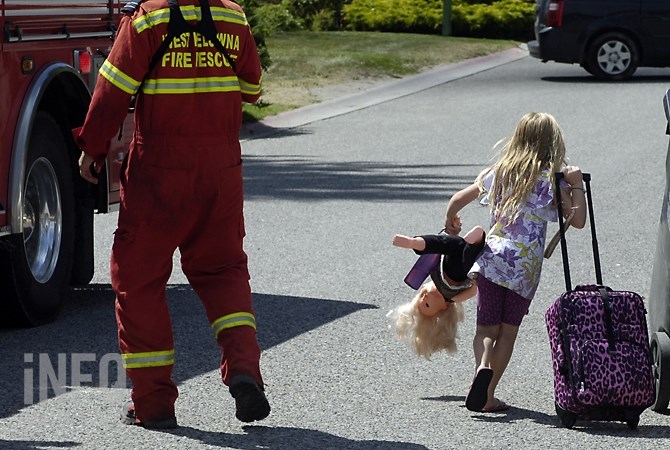
Residents being evacuated during a summer 2014 wildfire in West Kelowna.
(ADAM PROSKIW / iNFOnews.ca)
May 04, 2016 - 5:00 PM
VERNON - It’s one of those things you hope you never need to know: how to get out of your home, neighbourhood, or even your city if disaster strikes.
This week’s massive wildfire in Fort McMurray has proven crisis can happen anywhere, anytime. For the North Okanagan’s Inter-Municipal Emergency Program coordinator Helen Sinclair, it’s a perfect, if horrific, reminder of the importance of having a plan in the face of a catastrophe like a wildfire, severe weather, or a flood.
“You can say it’s never going to happen, but if it does happen, at least you have a plan,” Sinclair says. “It’s kind of like buying house insurance; you hope you never have to use it but if you do, it’s great to have.”
There are places in the North Okanagan that emergency responders know are hard to get out of, such as Silver Star in Vernon, where there is only one main road in and out. That’s why the Emergency Program has a plan in place which is updated every year and includes different evacuation routes and protocols for North Okanagan communities.
“We don’t release that information to the public because every situation is different. We could be using different routes for different situations, so by telling the public know to use this highway or this street could lead to confusion,” Sinclair says.
In the event of an emergency, Sinclair says emergency responders would determine the safest evacuation route and inform the public via the RCMP and the media.
“Any time you have a one way in or out, that obviously presents a bit of a challenge and is a concern. The nice thing about those areas is usually the people that live there have good local knowledge,” Sinclair says.
But no matter where you live, Sinclair says it’s important to be prepared.
“The only way to lessen the impact is to be prepared. Things like having a grab and go bag, an extra set of car keys, important documents,” Sinclair says.
Another important plan to have in place is where to meet if your family gets split up.
“If mom’s at work and dad’s at work, do the kids know who to call and where to meet?” she says.
She’s also encouraging people to work together as a neighbourhood in the event of a crisis.
“What if it’s not a fire, but a severe weather event — who has a generator? Get to know each other and pull together as neighbours,” she says.
While many believe they are safe from such disasters if they live in town, Sinclair stresses that wildfires, or any number of catastrophes, can displace people anywhere.
“By virtue of the fact we are going to be getting hotter and drier, it’s already getting dry out there, never say never. Our plan, and individual preparedness plans, they are your lifeline. Everyone has to have one,” Sinclair says.
To contact a reporter for this story, email Charlotte Helston or call 250-309-5230 or email the editor. You can also submit photos, videos or news tips to the newsroom and be entered to win a monthly prize draw.
We welcome your comments and opinions on our stories but play nice. We won't censor or delete comments unless they contain off-topic statements or links, unnecessary vulgarity, false facts, spam or obviously fake profiles. If you have any concerns about what you see in comments, email the editor in the link above.
News from © iNFOnews, 2016